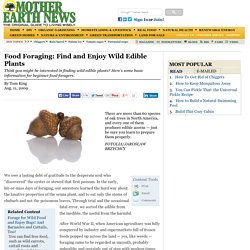

52 Wild Plants You Can Eat - Updated. Permaculture - What Is It and Why Is It Important? 18th March 2015 By Phil Watt Guest Writer for Wake Up World Developed by Australians Bill Mollison and David Holmgren in the 1970’s, permaculture has spread wildly throughout the world.

The term initially meant ‘permanent agriculture’, however it evolved to also represent ‘permanent culture’. Permaculture is the ethical, scientific and synchronistic design of natural systems to ensure a sustainable philosophy of living. Due to the unsustainable agricultural practices that we currently employ, permaculture is also an evidence-based solution to the self-destructive path we are on.
What is Permaculture? Permaculture is working in conjunction with nature, not against it. As a quick overview, a permaculture plot has five zones. The aim is to create systems that are ecologically-sound and economically viable, which provide for their own needs, do not exploit or pollute, and are therefore sustainable in the long term – Bill Mollison Permaculture is a design science. Why Is It Important? Foraging: 52 Wild Plants You Can Eat.
Here are a few common North American goodies that are safe to eat if you find yourself stuck in the wild: Blackberries: Many wild berries are not safe to eat, it’s best to stay away from them.

But wild blackberries are 100% safe to eat and easy to recognize. They have red branches that have long thorns similar to a rose, the green leaves are wide and jagged. They are best to find in the spring when their white flowers bloom, they are clustered all around the bush and their flowers have 5 points. Dandelions: The easiest to recognize is the dandelion, in the spring they show their bright yellow buds. Asparagus: The vegetable that makes your pee smell funny grows in the wild in most of Europe and parts of North Africa, West Asia, and North America. Elderberries: An elderberry shrub can grow easily grow about 10 feet and yield tons of food, their leaf structure is usually 7 main leaves on a long stretched out stem, the leaves are long and round and the leaves themselves have jagged edges.
Pine: Food Foraging: Find and Enjoy Wild Edible Plants. We owe a lasting debt of gratitude to the desperate soul who “discovered” the oyster or stewed that first possum.

In the early, hit-or-miss days of foraging, our ancestors learned the hard way about the laxative properties of the senna plant, and to eat only the stems of rhubarb and not the poisonous leaves. Through trial and the occasional fatal error, we sorted the edible from the inedible, the useful from the harmful. After World War II, when American agriculture was fully conquered by industry and supermarkets full of frozen foods popped up across the land — yes, like weeds — foraging came to be regarded as uncouth, probably unhealthy and certainly out of step with modern times. Why then, a half-century later, do we find purslane — a vigorous, succulent “weed” once routinely cursed by gardeners — on the menu of nearly every fine dining restaurant in the country? Kerri Conan blogs for The New York Times, and keeps a sharp eye on food trends. Learning the Art of Food Foraging 1. 2. 3.